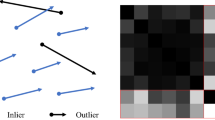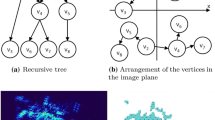Abstract
A model-based vision system attempts to find correspondences between features of an object model and features detected in an image for purposes of recognition, localization, or inspection. In this paper we pose the relational matching problem as a special case of the pattern complex recognition problem and propose a probabilistic model to describe the images of an object. This Bayesian approach allows us to make explicit statements of how an image is formed from a model, and hence define a natural matching cost that can be used to guide a heuristic search in finding the best observation mapping. Furthermore, we show that even though the nature of the feature matching problem is exponential, the use of the proposed algorithm keeps the size of the problem under control, by efficiently reducing the search space.
Similar content being viewed by others
References
R. Bolles and R. Cain, Recognizing and locating partially visible objects: The local-feature focus method, Int. J. Robot Res. 1(3) (1982) 57–82.
K.L. Boyer and A.C. Kak, Structural stereopsis for 3-d vision, IEEE Trans. Syst. Man Cybern. SCM-110(2) (1988) 144–166.
R. Brooks, Symbolic reasoning among 3-D models and 2-D images, Artificial Intelligence 17 (1981) 285–348.
O.I. Camps, PREMIO: The use of prediction in a CAD-model-based vision system, Ph.D. Thesis, Department of Electrical Engineering, University of Washington, Seattle, Washington (1992).
P.J. Flynn, CAD-based computer vision: Modeling and recognition strategies, Ph.D. Thesis, Michigan State University (1990).
C. Goad, Special purpose automatic programming for 3D model-based vision, in:Proc. of the Image Understanding Workshop, June 1983, pp. 94–104.
W.E.L. Grimson, The combinatorics of object recognition in cluttered environments using constrained search, in:Proc. Int. Conf. on Computer Vision, 1988, pp. 218–227.
C.D. Hansen, CAGD-based computer vision: The automatic generation of recognition strategies, Ph.D. Thesis, The University of Utah (1988).
R. Haralick, The pattern complex, in:Structural Pattern Analysis, eds. R. Mohr, T. Pavlidis and A. Sanfeliu (World Scientific, Singapore, 1989) pp. 57–66.
R. Haralick and L. Shapiro,Computer and Robot Vision (Addison-Wesley, New York, 1992).
R. Haralick and L.G. Shapiro, The consistent labeling problem: part i, IEEE Trans. Pattern Anal. Machine Intellig., PAMI-1(2) (1979) 173–184.
J. Henikoff and L. Shapiro, Interesting patterns for model-based matching, in:ICCV, 1990.
P. Horaud and R. Belles, 3DPO: A system for matching 3-D objects in range data, in:From Pixels to Predicates, ed. A. Pentland (Ablex, Norwood, New Jersey, 1986) pp. 359–370.
K. Ikeuchi, Generating an interpretation tree from a CAD model for 3D-Object recognition in bin-picking tasks, Int. J. Comp. Vision 1(2) (1987) 145–165.
R.E. Korf, Search: A survey of recent results, in:Exploring Artificial Intelligence eds. H.E. Shrobe and T.A.A. for Artificial Intelligence (Morgan Kaufmann, 1988) chap. 6, pp. 197–237.
L. Ott,An Introduction to Statistical Methods and Data Analysis, 2nd Ed. (Duxbury Press, Boston, MA, 1984).
A. Papoulis,Probability, Random Variables, and Stochastic Processes, 3rd Ed. (McGraw-Hill, New York, 1991).
A. Rosenfeld, R.A. Hummel and S.W. Zucker, Scene labeling by relaxation operations, IEEE Trans. Syst. Man Cybern. SMC-06 (June 1976).
A. Sanfeliu and K.S. Fu, A distance measure between attributed relational graphs for pattern recognition, IEEE Trans. Syst. Man and Cybern. SMC-13(13) (1983) 353–362.
L. Shapiro and R. Haralick, Structural descriptions and inexact matching, IEEE Trans. Pattern Anal. Machine Intellig. PAMI-3(5) (1981) 504–519.
L. Shapiro and R. Haralick, A metric for comparing relational descriptions, IEEE Trans. Pattern Anal. Machine Intellig. PAMI-7 (1985).
J.R. Ullman, An algorithm for subgraph homomorphisms, J. Assoc. Comput. Mach. 23 (1976) 31–42.
P. Winston,Artificial Intelligence, 2nd Ed. (Addison-Wesley, New York, 1984).
Author information
Authors and Affiliations
Rights and permissions
About this article
Cite this article
Camps, O.I., Shapiro, L.G. & Haralick, R.M. A probabilistic matching algorithm for computer vision. Ann Math Artif Intell 10, 85–124 (1994). https://doi.org/10.1007/BF01530945
Issue Date:
DOI: https://doi.org/10.1007/BF01530945




